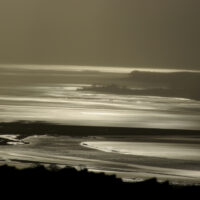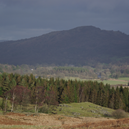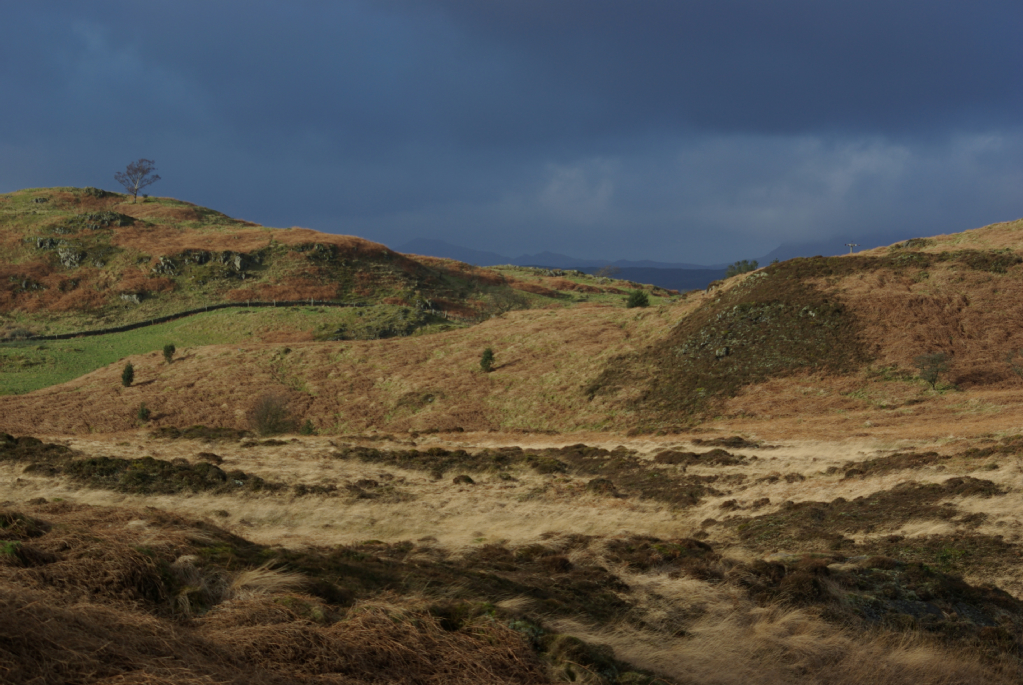Hockney is so right about light

Ever since Country File ran an interview with David Hockney about his recently started exhibition at the Royal Academy, I have been avidly reading and looking at, anything I can on the amazing images of his native Yorkshire Wolds, I am just seriously annoyed that I did not ‘get around’ to buying tickets last weekend as the first round have now sold out. Put myself on the email list and hope…
About the exhibition Hockney says “The paradox of East Yorkshire, is that, though the landscape is essentially unchanging, its weather is very changeable, altering the light and colour as the clouds pass overhead and the sun shifts position.” This can be said about much of our English landscape and today was such a day. The thick dark clouds vied with the winter sun and the low hills were silhouetted against the sky line with film like clarity.
The walk we followed was a stunning discovery, arising from the necessity to squeeze it in on a winter’s afternoon. Neither my friend Katie, or I had the whole day so I looked for somewhere close to home. Katie lives in Witherslack, so I consulted the Cicerone, South Lakes book and walk 37. I wasn’t totally convinced as the route was from Newby Bridge and south across the main A590. But necessity dictated and it was described as an 8 mile walk in ‘typical South Lakeland terrain’ and yes, it was. The book instructs you to park on the north side of the A590, by the Swan Hotel, and cross the road before taking a narrow road signed Canny Hill. We missed this bit out by driving up the road to Canny Hill and parking on the road side. But note, it is mid January and there were houses on this road who were obviously fed up of people, such as us, parking on the road side as there was a plethora of rocks to prevent destruction of the grass verge.
The track varies from well marked bridal way, to indistinct bog! Waterproof boots absolutely necessary. From one of the highest points, Bigland Barrow, we looked back and caught tantalising glimpses of the Coniston Fells. Unfortunately the fickle light did not reveal them for long and the best clarity was reserved for the much closer Gummers Howe. But looking south the low winter sun broke through the clouds and transformed the Leven Estuary in to monochrome.
walking over the top of Bigland Barrow the westerly’s hit us big time. Holding a camera still was impossible and am quite amazed that so many of my photos lack blur.
The presence of a few tarns in close proximity to the route, the most substantial being Black Beck and Bigland, ensure a boggy game of hopscotch. Trying to step from tuffet to tuffet slowed us down quite considerably. Although we have had more than our fair share of rain in recent weeks much of this route, I imagine, will still be somewhat aqueous in the height of a summer drought.
Being off the usual tourist route gave the advantage of not meeting ANY other walkers, though it was quite clear some of the paths were well used by the horses from Bigland Hall. The Belted Galloways were the only other sign of life we came across and thankfully the bull was far more interested in his harem than us.
Take a leaf out of Mr Hockney’s book and ‘look’ at the landscape. What you find and see may surprise you.
 |
|
|||||


Some of the photos on this blog are fantastic!
Fantastic photos – I LOVE the ones of the estuary and the tarn!!!
Thank you both! Glad you both enjoyed – more walking soon Katie!
Did this walk yesterday. Beautiful. Saw just one other walker, the Belted Galloways (incl the cute woolly bull!) and 3 gorgeous little young chestnut hairy pigs! My copy of the Cicerone book (which we know as “Aileen and Brian’s guide”) is from 1994 and had a couple of misleading directions! – and 10 deer